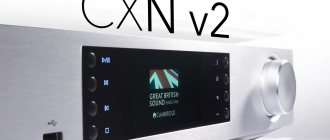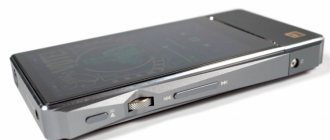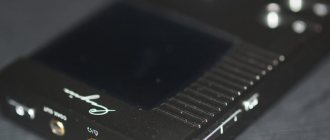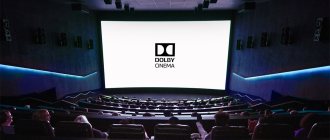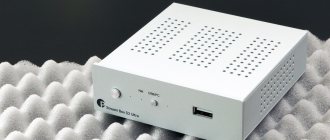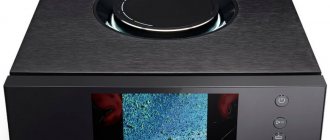The sound of operational amplifiers
Many of us like to listen to music in good quality, be it on a computer with a good sound card or on Hi-Fi equipment with a speaker system or on a portable player with headphones. We are all looking for the right sound due to taste and musical preferences.
As a rule, the main components involved in the color of the sound are: a digital-to-analog converter (DAC), operational amplifiers (OA) and circuit wiring. By replacing the amplifier with another, you can change the nature of the sound supply; in addition, the audio equipment manufacturer often provides for easy installation of an op-amp in the “crib”.
And even if the amplifier is soldered, replacing it with another will not be a Herculean task, you only need to know how to use a soldering iron. As a last resort, you can always take it to a workshop, where for a small fee they will replace the op-amp with the desired one.
By the way, buy opamps in trusted places so that you don’t get a fake and spoil the impression!
This article was written to help you navigate a wide selection of operational amplifiers, their features, and most importantly, their sound. Here are descriptions from the personal experience of users from the Internet about popular amplifier models.
It is worth noting that everything written does not claim to be true, because... a lot depends on the technology where the operational amplifiers are installed and of course on auditory perception.
Description of operational amplifiers (sound):
OPA1602 - clear highs, airy mids, extended stereo base, closer stage compared to LME49860, tight bass. The mids are not as dynamic as the LME49860, but outperform it with their musicality and natural sound. Slew rate 20 V/µs. This op-amp is a representative of the SoundPLUS line for high-end audio devices.
OPA1612 - the sound is almost accurate and smooth with a slight bias towards the bass register, the midrange is natural, the treble is collected and detailed. Ultra-low distortion 0.000015%, low noise op amp, slew rate 27 V/µs, gain 130 dB. It is used in professional audio equipment, test and measurement equipment for audio equipment, and high-quality AV receivers.
OPA1611 - exactly the same as OPA1612, but single-channel, an amplifier is placed on the left and right channels.
OPA1622 - similar in sound to OPA1612. Amplifier for professional equipment with excellent performance: output power up to 150 mW and a very low level of nonlinear distortion -135 dB, slew rate 10 V/µs. Low power consumption of 2.6 mA allows it to be used in smartphones, tablets, headphone amplifiers and external DACs.
OPA1642 - the sound, compared to the OPA2134, is even more developed throughout the entire range, perfectly suits percussion instruments, vocals, drums, bowed instruments, and wind instruments. Ultra-low distortion, 134 dB gain, 20 V/µs slew rate.
OPA1652 - accurate sound, with ultra-low harmonic distortion of 0.00005%, slew rate of 10 V/µs. This op-amp is a representative of the SoundPLUS line for high-end audio devices. Output signal amplitude up to 800 mV at 2 kOhm load. Load capacity up to 30 mA. Wide power range.
OPA1662 - the sound is almost precise and smooth with a slight bias towards the bass register, with ultra-low harmonic distortion of 0.00006%. Slew rate 17 V/µs. This op-amp is a representative of the SoundPLUS line for high-end audio devices.
OPA2134 - the sound is slightly softened, is considered warm, the middle, vocals, and wind instruments are very beautiful, but very subtle nuances are slightly blurred, popular and inexpensive. Slew rate 22 V/µs.
OPA134 - exactly the same as OPA2134, but single-channel, an amplifier is placed on the left and right channels.
OPA2132 - better sound than OPA2134, more detailed, very pleasant to the ear. Supports loads up to 600 ohms, low harmonic distortion of 0.00008%, slew rate of 20 V/µs.
OPA2140 - precision (selected) OPA2141, slightly more accurate and less noisy. Slew rate 20 V/µs.
OPA2141 - similar in sound to OPA1642. Slew rate 20 V/µs.
OPA2211 - neutral sounding, accurate, analytical, detailed sound with excellent tonal balance and resolution. A precision amplifier with high dynamic range and extremely low noise. Ultra-low distortion 0.000015%, low noise op amp, slew rate 27 V/µs, gain 136 dB.
OPA2322 - similar in sound to OPA2132. Slew rate 10 V/µs.
OPA2604 - excellent sound quality, rich, detailed. Very good control of the lower register, the sound plays with muscles. Excellent vocals without obvious artifacts, sound clarity is higher than on the LM4562. You can hear subtle nuances in the operation of the cymbals. The low noise amplifier in the OPA2604 provides wide dynamic range even with high source impedance.
OP27 - vintage sound, “bold”, bass and vocals sound beautiful, details are a little lost, low slew rate of 2.8 V/µs. Single-channel, placed on the left and right channels by an amplifier.
OP275 - the sound is good, but a little blurry. Gain up to 104 dB, bandwidth up to 9 MHz, good ripple suppression, distortion below 0.001% over a wide range of output voltages with load resistance above 100 Ohms. However, it is not compatible with any circuit design, especially with non-inverting connection, speed 22 V/µs.
OP285 - the same as the previous one, but selected for bias voltage (the best of OP275).
OPA564 - the sound is transparent, reliable, giving off a little “warmth”. High-power amplifier with output characteristics of 20V and up to 1.5A, slew rate 40 V/µs, THD+N = 0.003%. Wide operating power range from 3.5 to 24 V.
OPA627 - very high quality sound, high detail, bass elasticity, depth of the music scene, slew rate 55 V/µs. Single-channel, placed on the left and right channels by an amplifier.
OPA926 - the sound depends on the circuitry. As for example in the FiiO X7 Mark II + AM3A module, the sound is soft, with smoothed details and a slight bias towards the middle. And the FiiO M11 has excellent detail, the sound is accurate and “even” like the OPA1622. Made specifically for FiiO, it features lower distortion of 0.0003% at 32 ohms, minimal noise and overall cleaner sound compared to the AD8397.
LM4562 - the sound has a specific cold tint, a deep and rather sharp lower register on drums, and accentuated highs, 20V/µs. Gain up to 140 dB, bandwidth up to 30 MHz. Ultra-low noise, low distortion. Load up to 600 ohms without increasing distortion, output current up to 20 mA, excellent ripple suppression. It sounds without the slightest sign of coloring. But it suffers from the problem described for OP275.
LME49720 - the sound is clearly different from the LM4562, a flat stage with disappearing reverberation.
LME49860 - the sound is pleasant to the ear, devoid of the shortcomings of the LM4562, exceptional detail throughout the entire frequency range, the highest quality of LM amplifiers, with an increased operating voltage of up to 44V, slew rate of 20 V/µs.
LME49990 - the sound is not completely analytical, but pleasant. 135 dB high gain, 0.00001% THD, ±27 mA output current, drives loads up to 600 ohms, 22 V/µs slew rate.
LM6172 - amazingly transparent sound for classical, jazz, blues and other live recordings, has a very soft and airy sound. Gain up to 86 dB, bandwidth up to 100 MHz. Low noise, distortion below -100 dB into 100 ohms, powerful up to 50 mA output current and very fast, slew rate 3000 V/µs.
LM7372 - gain up to 85 dB, bandwidth up to 120 MHz. An output current of up to 150 mA, a harmonic level of 100 dB, is good for everyone, but with a load resistance below 150 Ohms, distortion begins to increase sharply, eventually breaking the -80 dB bar.
LS6132 is a Chinese copy of the TPA6132A2 and PAM8908 amplifier, with a harmonic distortion coefficient of 1% and an output power of 33 mW per channel.
MAX97220 - the sound is soft, accentuated on the midbass and mid frequencies, the upper frequencies are smoothed, a fairly large output power of 125 mW, well suited for the headphone output.
Maxim MAX98512 - the sound is smooth, detailed, close to analytical.
MUSES8820 - imposing sound, soft “tube” sound with swollen bass, vintage amplifier.
MUSES8920 - bright sound, separation of instruments, scale of sound, dynamics, sonority of its quality.
MUSES01 - the sound is smooth, neutral, with high detail, plenty of air and clear positioning of instruments. The detail of the voice, mids and highs sound mesmerizing, but the bass is a little dry, although it is fast and punchy.
MUSES02 - transparent, pleasant sound, dynamic opamp, with good resolution, more bass than MUSES8920, but otherwise they are similar.
MUSES03 - the best sound is taken from MUSES01 and MUSES02. The stage acquired absolutely clear boundaries, became even deeper and wider. The images are clear and crisp, with air between them, instruments do not interfere with each other, high resolution. All this is very clearly positioned in space. For example, a drum set with cymbals, when recorded well, sounds so that you can clearly hear when which cymbal was hit, closer-further, higher-lower, left-right - the highest effect of presence.
PAM8901 / PAM8908 - Sound very similar to TPA6132A2. Dense bass, good development of the midrange, treble slightly smoothed out. A good amplifier, widely used in wireless headsets and headphones, with a harmonic distortion coefficient of 0.03% and an output power of 25 mW per channel.
SABER ES9603 - the sound is towards the monitor level, the bass is collected and clear (without muttering), the mids are clear, the high frequencies are detailed without unnecessary “clicking”, good stage width. The amplifier is not sensitive to load and produces fairly stable performance at different loads.
SSM6322 is an amplifier for increasing the accuracy of audio transmission in Hi-Fi applications in portable equipment, including mobile phones, designed for loads up to 32 Ohms, with a fairly high output current of 100 mA. The sound is quite clean, without “booming” in the lower range and neatly smoothed high frequencies, without loss of detail.
TFA9891 / TFA9892 - sound with a bias towards the mid and low frequency range. High performance class D amplifiers (at 12V to 15W) for portable devices. Harmonic distortion 1%.
TPA3116 D2 - sounds clean, bodily, live vocals, drums sound great, textured cymbals with a natural presentation, not sandy, the stage is average. Class D amplifier, signal to noise 102 dB, distortion level 0.1%.
TPA6120 - the sound practically does not embellish, is powerful, prefers a high-impedance load (from 60 Ohms), harmonic distortion increases as the resistance decreases. The chip contains two independent channels with separate power pins. On each channel: output power 80 mW into a load of 600 Ohms with a power supply of ± 12V, with a distortion level of 0.00014%, dynamic range more than 120 dB, signal-to-noise level 120 dB, power range ± 5V to ± 15V, slew rate 1300 V/μs.
TPA6132A2 - marked as "AIWI". The sound has a bias towards the lower register, rich bass, high-quality development of the midrange, the treble is slightly smoothed out. A good amplifier, widely used in wireless headsets and headphones, with a harmonic distortion coefficient of 0.01% and an output power of 25 mW per channel.
TPA6530 - sounds smooth and soft, the midrange is most developed, the highs are smoothed out, and the low frequency range lacks the elasticity of the bass.
TA8254BHQ - sound without obvious distortions, a normal amplifier with high output power and low distortion level of 0.02%. Often used in car audio systems.
ADA4896-2 / ADA4897-1 / ADA4897-2 - powerful sound, continuous presentation, with a bias towards lows and mids, soft highs, which may lack airiness. Stable at unity gain and fast response 120 V/µs amplifier, with voltage feedback, low operating current of 3 mA, and low noise. Has a bandwidth of 230 MHz and a wide supply voltage range from 3 V to 10 V. Suitable where high dynamic range, accuracy and speed are required. The ADA4896-2 is available in 8-pin LFCSP and MSOP packages. The ADA4897-1 is available in an 8-lead SOIC package and a 6-lead SOT-23 package. The ADA4897-2 is available in a 10-pin MSOP package.
AD45257 - the strengths of the sound of this amplifier are voice, deep bass, spacious stage.
AD45275 - the sound is soft, lacks airiness and detail, the stage is quite narrow, the instruments seem to be in one row. Low noise amplifier with 180 MHz bandwidth and 225 V/µs slew rate.
AD823 - the sound is quite sharp at high, the stage is good, slightly worse than the AD8066, gain up to 95 dB and up to 9 MHz. Distortion is below -100 dB, but at output currents of more than 20 mA it increases like an avalanche. At a load of 32 Ohms, the power delivered without distortion is only 6 mW.
AD826 – sounds good, builds the stage well, for stronger bass and cohesion, “dark” amplifiers, good for rock. Gain up to 77 dB and up to 50 MHz, speed 350 V/µs. In fact, it is a unity-gain compensated AD828, with all its advantages, but much more stable. The small loss in power ripple suppression is compensated by the ability to easily handle capacitive loads.
AD827 - the same as the previous one, with a weakened output stage, slew rate 300 V/µs.
AD828 - sounds very good, but is not stable in all circuits. Gain up to 80 dB and up to 100 MHz. Capable of providing 2 V amplitude even into a 10 ohm load. Without distortion, it supplies up to 50 mA of current to the load. The harmonic level at gain = 2 smoothly tends to -100 dB, and this is an excellent result. It is low noise and has good ripple suppression, slew rate 450 V/µs.
AD8022 - the output current is high, which is good for low-impedance headphones, the harmonic level does not exceed -110 dB at 600 Ohms and higher, the slew rate is the same as the AD8620, there is less noise, it is good to install at the output, the slew rate is 50 V/µs. Gain up to 72 dB and up to 100 MHz. Ultra low noise, twice the load capacity of the AD8066, but requires a regulated power supply.
AD8066 is a very high-quality sound, universal amplifier. Deep low frequencies, considered transparent sound, similar to AD8620, but lighter, lighter and more accurate (analytical) sound, application area studio equipment where accurate, uncolored sound is important, slew rate 180 V/µs. Up to 114 dB and up to 65 MHz gain. Harmonic levels are well below -95 dB into loads greater than 150 ohms. The output current amplitude is up to 30 mA, which may not be enough for some low-impedance headphones. Good ripple suppression.
AD8034 - similar sound to AD8066, gain up to 96 dB and up to 40 MHz. At a load of 1 kOhm, the harmonic level is below -100 dB, but already at 500 Ohms it jumps to -85 dB.
AD8397 - sounds neutral, wide stage, high output current up to 310 mA, well suited for headphone output, but a little noisy, prone to excitation, demanding on the wiring diagram, slew rate 53 V/µs.
AD8599 - neutral sound, slightly narrow stage, ultra-low noise with gain up to 10 MHz and 116 dB. Distortion is less than 0.0005% at 2k ohms, but rises to 0.002% at 600 ohms. It handles capacitive loads well, has excellent power rejection and an output current of up to 50mA.
AD8620 - sounds good, but not in all circuits, sometimes there is not enough expressiveness, less noise than AD8066, slew rate 50 V/µs. Large gain (more than 105 dB) with a bandwidth of up to 25 MHz, distortion is less than 0.001%, but increases sharply with decreasing load resistance.
AD711 - vinyl rips sound more tube-like and warmer, old amplifier.
The AD712 is a unity gain compensated version of the previous amplifier.
AD744 - sounds very nice, although it blurs some details, a kind of compromise between detail and “meat”.
AD746 - similar in sound to Burr-Brown, has a high gain of 10 MHz and 116 dB. Distortion does not exceed -110 dB, the op-amp has good ripple suppression, and is operable with low-impedance loads (at currents less than 20 mA).
AD797 - The sound is almost neutral, but still embellishes a little. In conjunction with other op amps it gives excellent results. Output current up to 50 mA, slew rate 20 V/µs.
AD845 - wide sounding, one of the best AD amplifiers. slew rate 100 V/µs.
AD8512 - sounds a little rougher than the AD823, with less naturalness in the high frequencies, but better bass development. Gain up to 100 dB, bandwidth up to 8 MHz. Good output current up to 70 mA, excellent ripple suppression, low noise, high-impedance load distortion below 0.0001%.
AD8672 - the sound is smooth and clear, compared to the AD823 there are more detailed high frequencies and more developed low frequencies. Huge gain of 135 dB, bandwidth up to 10 MHz. Distortion is low, but the output stage cannot handle large signal amplitudes with low-impedance loads.
Cirrus Logic CS35L40 - clear, smooth and detailed sound, with a good volume reserve.
Cirrus Logic CS35L41 is a powerful Class D mono sound amplifier with DSP for speakers of mobile devices with peak performance of 5.3 W and 11 V. Provides built-in speakers with clear, rich sound without overloads leading to “wheezing”.
Cirrus Logic CS43130 - emotional sound, with the coloring of tube amplifiers and vinyl players. Built-in amplifier DAC designed specifically for mobile devices with low noise and low power consumption.
HT4832 / HT4831 is a Chinese copy of the TPA6132A2 and PAM8908 amplifier, with a harmonic distortion coefficient of 0.014% and an output power of 20 mW per channel.
JRC4558 - the sound is not bad, a fairly powerful amplifier up to 600 mW, with minimal distortion, slew rate 200 V/µs.
NE5532P - soft sound, an old time-tested decent amplifier, you shouldn’t expect anything “extra” from it, slew rate 9 V/µs.
LT1355, LT1358, LT1361, LT1364 - a family of four op-amps with high (LT1355 and LT1358) and very high (LT1361 and LT1364) slew rates (from 12 MHz and 400 V/μs to 70 MHz and 1000 V/μs). Good noise reduction, increased stability with capacitive load, distortion of the order of 0.0007% up to 2 kHz. The sound of the LT1364 is almost neutral, very detailed, and the mids stand out a bit.
LT1469 - the sound is clean and transparent, smooth throughout the entire range. He is not harsh or loud or soft. Very low distortion in high impedance loads and excellent rejection, over 110 dB gain, up to 45 MHz bandwidth, 22 V/µs. Low output current and slight indifference to capacitive load. Excellent option for I/U.
LT1498 - gives the sound an analog color, slightly highlighting vocals, musical, has a high signal-to-noise ratio, slew rate of 6 V/µs.
BUF634 - buffer, high-speed current follower up to 250 mA, slew rate 2000 V/µs, increases output signal power without audio coloration.
LMH6643 / LMH6644 - buffer, current follower up to 75 mA, slew rate 130 V/µs, increases the output signal power without coloring the sound.
Burson Audio Supreme Sound Op-Amp are specialized discrete operational amplifiers built on selected elements for use in the amplifier stages of high-quality audio equipment. SS (Supreme Sound) have a wider frequency bandwidth and can operate over a wide range of supply voltages, and these characteristics are key to sound quality in analog audio amplifiers.
Burson Audio Supreme Sound Opamp V5i - warm, emotional sound. The bass is accentuated, layered, with good separation of instruments in this range. Mid frequencies and voice are very emotional. HF is neatly pushed into the background.
Burson Audio Supreme Sound Opamp V5 - The V5 has a similar sound quality to the V5i, but with even more detail and better imaging.
Burson Audio Supreme Sound Opamp V6 Classic - The V6 sounds even more different than the V5. Thanks to a completely different circuit design of the output stage, it is even more emotional - the emphasis here is most on the mid frequencies.
Burson Audio Supreme Sound Opamp V6 Vivid - dynamic and transparent sound. From incredible dynamic range, three-dimensional soundstage, to the ability to reproduce the smallest micro-details.
THX AAA (Achromatic Audio Amplifier) is a patented integrated solution for placing a group of operational amplifiers in a separate unit with a specially designed harness for them. This implementation allows you to reduce energy consumption, reduce intermodulation, harmonic and transient distortion and achieve the most realistic sound.
THX AAA-28 (OPA1662, also known as OUQI, is used) - the sound has the character of a soft presentation, - slightly raised lower frequencies, smooth mids, smoothed high frequencies, the stage is below average.
THX AAA-78 (OPA1662, LMH6644, OPA1442 are used) - the sound is quite smooth, with a micro-emphasis on low frequencies, smooth and correct mids, the highs are just a little smoothed out without loss of detail and air, with a deep aftersound.
THX AAA-788 (OPA1602, TPA6120A, OPA926 are used) - the sound is almost smooth, with the correct tonality, there is a slight smoothing of the high-frequency range.
THX AAA 789 (OPA564, OPA1602 are used) - the sound can be called monitor, absolutely smooth throughout the entire frequency range, very detailed, conveying all the micronuances.
THX AAA-888 (OPA564, OPA1612 are used) - the sound can also be called monitor, absolutely smooth throughout the entire frequency range, very detailed, conveying all the micronuances. It differs from THX AAA 789 only in its slightly warmer sound.
Where and which one is better to put in the audio path?
In low-pass filters (LPFs), it is better to install op-amps with a high slew rate (high-speed).
It is better to install a more powerful one in the output path (I/O), either in current (for low-resistance loads) or in voltage (for high-resistance loads).
For example, the following are more suitable for low-impedance headphones: LM6172, AD828, AD8599, OPA1612, OPA1622.
The following are more suitable for high-impedance headphones: AD8066, AD8022, AD826, AD8620, TPA6120, LM4562, OP275, LT1364.



